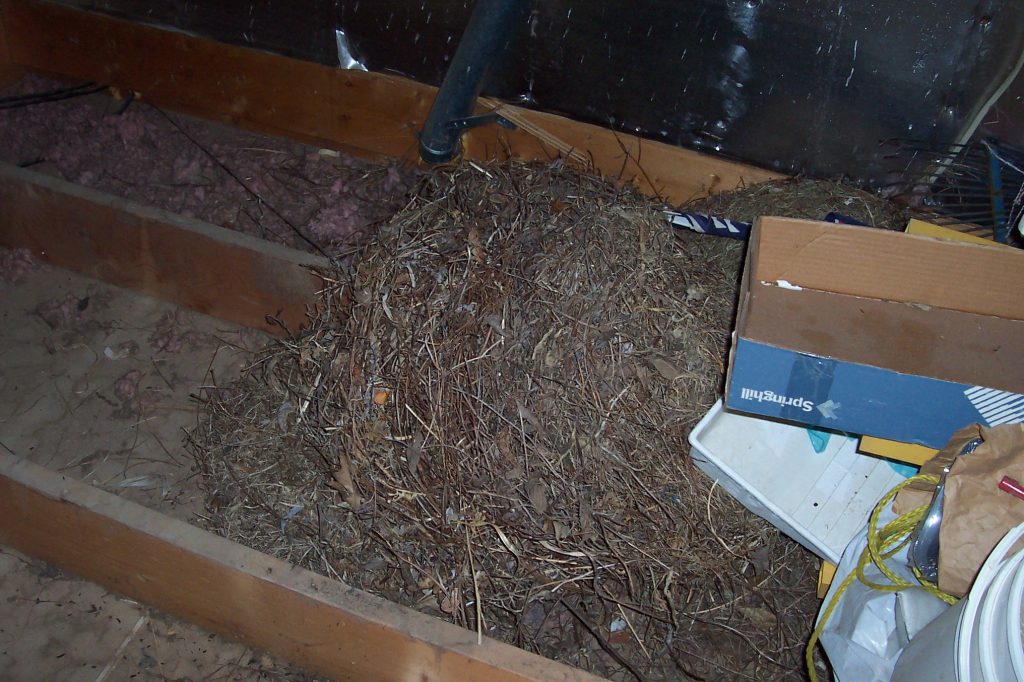House mice use a wider variety of materials for their nests, creating a round ball between four and six inches in diameter. Nesting material may include wood chips, pellets, vinyl, plastic, papers, carpet, cardboard boxes, drywall, and insulation. The nest may not be as tightly woven as a rat nest.
Mice nests have multiple purposes, like storing food and housing newborn pups.

Most Common Places to Find a Mouse Nest in the House
- Attics
- Walls
- Crawl Spaces
- Kitchen cabinets
- Pantry
- Closets
- Garages
- Benhind Kitchen Appliances
- Hoods of Vehicles
How to Find a Mouse Nest
Finding a house mouse’s nest means following urine, feces trails, gnaw marks on walls, floors, and cabinets, and rub marks along baseboards. If you notice wood shavings or small piles of materials, they could be items a mouse dropped on its way back to a nest. House mice usually leave obvious signs of food contamination near the things they destroy, like crumbs and droppings.
House mice will build nests near food sources but they rarely travel more than 30 feet from their nests. They will travel in all directions, claiming all the territory within the circle. This behavior does not make them easier to trap, however. Also, house mice leave their nests about forty times daily for food and water. Mice live in colonies, and you may have one or two dozen living in the same area. How to Get Rid of a Mouse Nest
When getting rid of a mice’s nest, your first instinct may be to pick it up, shake it apart, or dump it in the garbage can. Ignore this instinct. Mice carry diseases like Hantavirus and pass them on to humans via direct and indirect means. You may get bitten if you reach for a nest and a mouse is in it. Rodent nests are also filled with feces, urine, and parasites. Touching a nest without protection puts you at risk of encountering mold spores, bacteria, fleas, and ticks, among other unsavory encounters.
Getting rid of mouse nests involves steps that vary based on the species. Simply trapping them will not prevent future infestations. Call Critter Control service to resolve your rodent problem. These experts will perform extensive inspections, use the correct baits and traps, and implement exclusions to block mice entry points. Most importantly, they have the right tools and equipment to remove and sanitize the nest area safely.
Get them out.
Keep them out.®
Experiencing a wildlife or pest issue? We can help! Complete this form and your local Critter Control® office will contact you to assist.
- Baby Mice
- Dead Mice
- How to Get Rid of Mice
- Mice Behavior in the Winter
- Fear of Mice
- How to Catch a Mouse
- Life Cycle of a Mouse
- Mice in Attic Removal
- Mice in Crawl Space
- Mice in the House
- Mice in the Walls
- Mice in Yard
- Mice Problems
- Mouse Poop & Droppings
- Mice in Pantry
- Mouse Noises
- Mouse Repellent
- Mouse Tracks
- Mouse Traps & Bait
- Mice vs. Rats
- Types of Mice
- Diseases That Mice Carry
- Mouse Appearance
- Where Do Mice Hide?
- White Footed Mouse Habitat